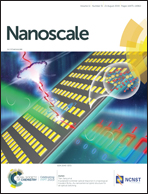Super-resolution imaging of cancer-associated carbohydrates using aptamer probes†
Abstract
Globo H, as one of the most crucial cancer-associated carbohydrates, is exclusively overexpressed in a variety of cancers. However, the accurate localization and detailed morphology of globo H at the molecular level remain unclear. Here, we applied direct stochastic optical reconstruction microscopy (dSTORM) and relied on fluorophore-conjugated aptamers to solve the problem. The results showed that globo H organized as clusters on cell membranes with irregular shapes and different sizes from 100 to 300 nm. Significantly, globo H was found to have a higher expression level and larger clusters on various cancer cells than on non-cancer cells, which hinted that its specific distribution could be utilized for cancer diagnosis. Moreover, dual-color dSTORM imaging revealed the colocalization of globo H and other cancer-associated carbohydrates, and the clustering of globo H could be disrupted by the treatment of corresponding glycosidases, which indicated that these carbohydrates might intertwine in spatial organization and function cooperatively in cancers. Our work clarified the clustered distribution of globo H at the nanometer scale and revealed the potential interactions between cancer-associated carbohydrates, which paves the way for further understanding the relationship between the spatial structures and functions of carbohydrates in cancers.



 Please wait while we load your content...
Please wait while we load your content...